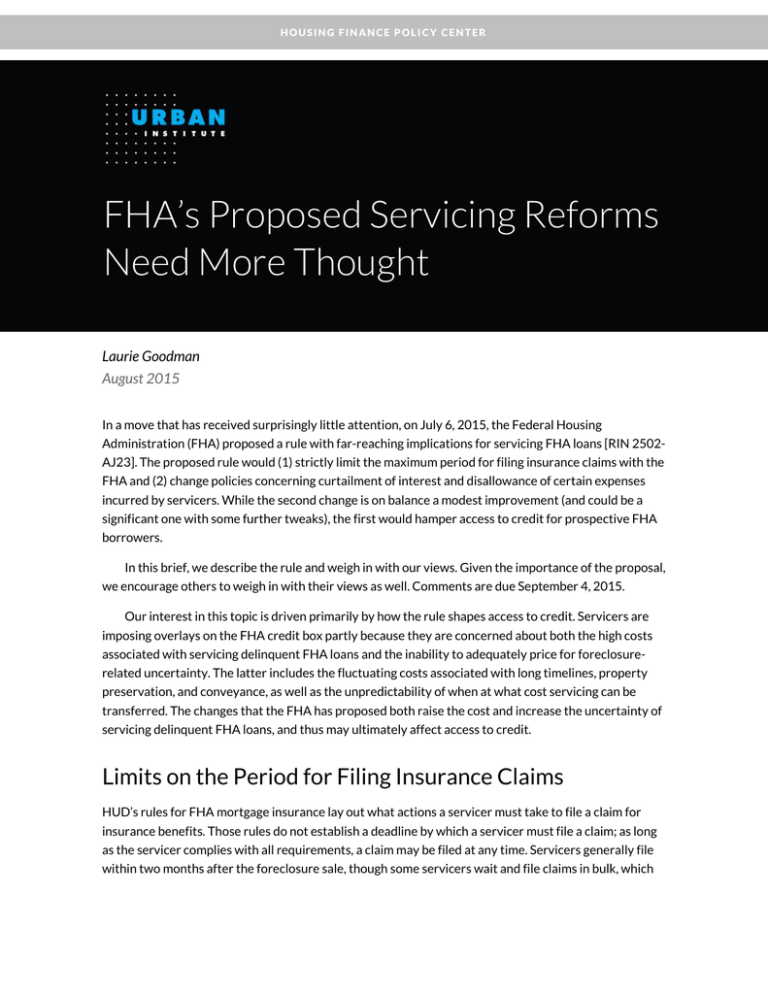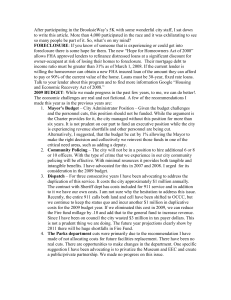FHA’s Proposed Servicing Reforms Need More Thought Laurie August
advertisement

HOUSING FINANCE POLICY CENTER FHA’s Proposed Servicing Reforms Need More Thought Laurie Goodman August 2015 In a move that has received surprisingly little attention, on July 6, 2015, the Federal Housing Administration (FHA) proposed a rule with far-reaching implications for servicing FHA loans [RIN 2502AJ23]. The proposed rule would (1) strictly limit the maximum period for filing insurance claims with the FHA and (2) change policies concerning curtailment of interest and disallowance of certain expenses incurred by servicers. While the second change is on balance a modest improvement (and could be a significant one with some further tweaks), the first would hamper access to credit for prospective FHA borrowers. In this brief, we describe the rule and weigh in with our views. Given the importance of the proposal, we encourage others to weigh in with their views as well. Comments are due September 4, 2015. Our interest in this topic is driven primarily by how the rule shapes access to credit. Servicers are imposing overlays on the FHA credit box partly because they are concerned about both the high costs associated with servicing delinquent FHA loans and the inability to adequately price for foreclosurerelated uncertainty. The latter includes the fluctuating costs associated with long timelines, property preservation, and conveyance, as well as the unpredictability of when at what cost servicing can be transferred. The changes that the FHA has proposed both raise the cost and increase the uncertainty of servicing delinquent FHA loans, and thus may ultimately affect access to credit. Limits on the Period for Filing Insurance Claims HUD’s rules for FHA mortgage insurance lay out what actions a servicer must take to file a claim for insurance benefits. Those rules do not establish a deadline by which a servicer must file a claim; as long as the servicer complies with all requirements, a claim may be filed at any time. Servicers generally file within two months after the foreclosure sale, though some servicers wait and file claims in bulk, which means that some claims aren’t filed for many months. This delay often results in a larger reimbursement to servicers (for taxes, insurance, home maintenance expenses, homeowner association dues, and so on) and a greater decline in property value due to delayed maintenance. The delay also makes it harder for the FHA to project the state of the Mutual Mortgage Insurance Fund. The proposed rule would set specific timelines for filing claims on all loans made going forward. A claim must be filed no more than 12 months after the “reasonable diligence time frame,” or RDT, expires. For this purpose, the RDT is measured from the date of default (usually defined as 30 days after the first missed payment) and varies by state, from 3 months in Texas to 19 months in New York.1 If a servicer does not file a claim within 12 months of the end of the RDT for its state, the FHA insurance terminates automatically. The rule would also require that claims on properties acquired through foreclosure be filed within three months of the latest of the following four events: (1) the date of the foreclosure sale, (2) the date the redemption period expires, (3) the date the servicer acquires possession of the property (i.e., the property is vacant), and (4) “such further time that is approved in writing.” In no circumstances can a claim be filed more than 12 months after the RDT expires, unless the FHA grants an extension. If a claim is not filed in a timely manner, the servicer retains ownership of the property and forfeits the right to claim for insurance benefits. For a property sold through a pre-foreclosure sale, the servicer must file a claim for benefits no later than three months following the date of the closing. For claims without conveyance of title the servicer must file no more than 12 months after the RDT expires. For property acquired through a deed-in-lieu of foreclosure, the servicer must file for insurance benefits no later than three months following the date of conveyance of the property to the servicer or the date of conveyance to HUD, the date of execution of the deed by the borrower, or no more than 12 months after the RDT. Problems from the Lender or Servicer Perspective The proposed timeline raises a number of problems. First, the RTD-plus-12-month time frame to file a claim is simply unrealistic.2 With reasonable diligence time frames ranging from 3 to 19 months, the 12-month post-RDT bar would be reached in 15 to 31 months. Yet the FHA’s own numbers show, for loans liquidating in May 2015, the average time from default to claim is 31.75 months.3 Thus, many loans that go through the REO process will miss the deadline, and their insurance will be terminated. To examine these FHA timelines on a state-by-state basis, we conducted an original analysis using CoreLogic servicing data. For loans that were conveyed to HUD in 2014 and the first half of 2015, we come very close to matching HUD’s mean value nationwide. Our results are shown in the far right section of table 1. Note that in almost all of the states (48 out of 51 [including the District of Columbia]) the mean timeline from default to conveyance is longer than the RDT plus 12 months. The difference is greater than 6 months in 33 states; greater than 1 year in 16 states; and greater than 18 months in 6 2 FHA SERVICING REFORMS NEED MORE THOUGHT states. These differences do not take into account FHA-approved extensions, but they do illustrate the magnitude of the problem. Moreover, we are looking at mean timelines; many loans are longer than the mean. Finally, our analysis may understate this issue in some of the very long timeline states, such as Connecticut, Florida, New Jersey, and New York, where many of the most difficult-to-liquidate loans are still sitting in the delinquency pipeline several years after foreclosure. The final time frame will be extremely long by the time these difficult-to-liquidate loans make it to liquidation. Servicers are given 3 months to get from property acquisition to conveyance, yet the FHA’s own numbers indicate that the deed transfer period (the time from completion of foreclosure to HUD acquisition date) averages 10.1 months for loans that liquidated in May 2015. Plus, the Mortgagee letter setting these timelines (2013-38) was dated October 28, 2013. Since then, total timelines have increased almost 5 months, including a 3.6-month increase in the deed transfer period. While the proposed rule only covers new loans, there is no reason to think these timeline problems will disappear. Rather, the large increase in the deed transfer time in the past two years, in part attributable to Mortgagee Letter 13-18, which imposed additional requirements on title prior to conveyance, suggests the problems in meeting timelines will persist. The requirement that the servicer deliver the property on which an insurance claim is made to HUD in conveyable condition makes the timeline still more unrealistic, especially when the property is extensively damaged or is in a high-vandalism area. Conveyable condition in such areas often requires extensive repairs, which can take more than three months. Servicers can get extensions from HUD’s Compliance Contractor, but they cannot always count on getting one. And, if the servicer does not get an extension, the penalty is very severe: termination of insurance. The three-month deadline can also be an issue when there are problems gaining clear title. One related issue is that the demand for extensions is likely to increase dramatically because the extensions will be necessary for the servicer to avoid termination of insurance. FHA is not staffed for this, nor do they have the systems in place to manage it. Such an increase in demand would likely lead to longer processing timelines for extensions. Moreover, the timeline does not toll while the request is being reviewed, which increases the probability of insurance termination. Second, the proposed rule is silent on how to handle reconveyances. As we pointed out in our December 16, 2014, brief, “Servicing Is an Underappreciated Constraint on Access to Credit” (Goodman 2014), servicers are required to foreclose on the property, then convey the property to the FHA after completing repairs to bring the property to “conveyable condition.” What “conveyable condition” means is unclear; it is usually interpreted as removing hazardous material and broom sweeping. However, some HUD officials want to see the properties in marketable condition, which is a much higher standard. If a property is conveyed, then found not to be in conveyable condition, the property will be reconveyed to the lender. It is unclear how these reconveyances affect the timelines or how they would be treated under the proposal. FHA SERVICING REFORMS NEED MORE THOUGHT 3 TABLE 1 Mean FHA Foreclosure Timelines by State (Months) State AK AL AR AZ CA CO CT DC DE FL GA HI IA ID IL IN KS KY LA MA MD ME MI MN MO MS MT NC ND NE NH NJ NM NV NY OH OK OR PA RI SC SD TN TX UT VA VT WA WI WV WY All Default to foreclosure 9.6 12.8 17.5 8.3 7.2 12.1 10.7 6.6 14.2 8.4 12.6 7.3 10.9 9.1 10.2 9.1 10.5 10.7 11.4 6.0 12.6 7.6 9.9 8.8 10.8 12.2 11.4 11.0 8.4 8.7 9.8 10.4 10.8 11.0 9.4 10.2 11.9 8.2 10.4 7.4 9.2 10.2 12.3 10.5 13.1 11.7 10.0 15.2 10.5 8.3 9.7 10.7 Period in excess of deadline to file foreclosure 3.6 6.8 11.5 2.3 1.2 6.1 4.7 0.6 8.2 2.4 6.6 1.3 4.9 3.1 4.2 3.1 4.5 4.7 5.4 0.0 6.6 1.6 3.9 2.8 4.8 6.2 5.4 5.0 2.4 2.7 3.8 4.4 4.8 5.0 3.4 4.2 5.9 2.2 4.4 1.4 3.2 4.2 6.3 4.5 7.1 5.7 4.0 9.2 4.5 2.3 3.7 4.7 Foreclosure to conveyance RDT 10.3 12.1 14.7 8.8 9.5 12.1 26.0 41.2 25.5 35.9 12.9 40.4 23.0 18.4 24.2 18.1 15.0 18.4 23.0 21.1 25.5 30.8 11.2 11.3 9.0 16.5 19.7 16.3 26.2 9.6 11.1 38.6 24.2 18.3 37.1 20.8 21.2 29.2 23.9 19.7 17.8 16.2 12.4 13.4 15.3 12.7 25.2 14.7 17.9 10.5 8.8 19.7 5 4 5 5 7 7 10 7 9 15 4 9 17 8 12 11 9 9 8 8 6 14 9 10 4 9 7 5 8 6 4 15 9 7 19 12 9 7 11 6 9 10 4 3 11 4 14 6 12 5 6 8.7 Period in excess of RDT 5.3 8.1 9.7 3.8 2.5 5.1 16.0 34.2 16.5 20.9 8.9 31.4 6.0 10.4 12.2 7.1 6.0 9.4 15.0 13.1 19.5 16.8 2.2 1.3 5.0 7.5 12.7 11.3 18.2 3.6 7.1 23.6 15.2 11.3 18.1 8.8 12.2 22.2 12.9 13.7 8.8 6.2 8.4 10.4 4.3 8.7 11.2 8.7 5.9 5.5 2.8 10.9 Default to conveyance 20.0 24.9 32.2 17.1 16.7 24.2 36.7 47.8 39.7 44.3 25.5 47.7 34.0 27.5 34.4 27.1 25.5 29.2 34.4 27.1 38.0 38.4 21.2 20.1 19.8 28.7 31.1 27.3 34.7 18.3 20.9 48.9 35.0 29.3 46.5 31.0 33.1 37.4 34.3 27.1 27.0 26.4 24.7 23.9 28.3 24.4 35.2 29.9 28.4 18.7 18.5 30.3 Max time to file insurance claim Period in excess of insurance claim deadline 17 16 17 17 19 19 22 19 21 27 16 21 29 20 24 23 21 21 20 20 18 26 21 22 16 21 19 17 20 18 16 27 21 19 31 24 21 19 23 18 21 22 16 15 23 16 26 18 24 17 18 20.7 3.0 8.9 15.2 0.1 -2.3 5.2 14.7 28.8 18.7 17.3 9.5 26.7 5.0 7.5 10.4 4.1 4.5 8.2 14.4 7.1 20.0 12.4 0.2 -2.0 3.8 7.7 12.1 10.3 14.7 0.3 4.9 21.9 14.0 10.3 15.5 7.0 12.1 18.4 11.3 9.1 6.0 4.4 8.7 8.9 5.3 8.4 9.2 11.9 4.4 1.7 0.5 9.6 Sources: RDT from HUD Mortgagee Letter 2013-38, October 28, 2013. Mean foreclosure timelines calculated from CoreLogic Servicing data by Urban Institute. Note: FHA = federal housing administration; RDT = reasonable diligence time frame. Table includes FHA loans that entered REO in 2014 and H1 2015. FHA SERVICING REFORMS NEED MORE THOUGHT 4 Finally, having the insurance terminate automatically and without notice will generate considerable uncertainty for lenders and servicers. In some cases, they will not know when they have violated the guidelines. For example, assume that a servicer forecloses on a property and the borrower initially refuses to leave but eventually elects to do so. The three-month clock begins ticking when the home is vacant, because the servicer has already acquired title, but it may take several weeks before a servicer knows that a borrower has moved out of the home. This delay could not only truncate the servicer’s time to file a claim, but also mean neither the servicer nor the FHA knows precisely when the threemonth filing period begins. Problems from the Borrower and Market Perspectives The proposed rule also raises concerns for servicers, borrowers, Ginnie Mae (GNMA), and the mortgage market as a whole. The aggressive time frame could have negative consequences for borrowers who could benefit from loan modifications late in the foreclosure process. Currently, servicers can put foreclosures on hold to help borrowers stay in their homes. The new rules make the timelines so strict and the punishment so draconian that servicers may not be willing to review options late in the process. GNMA is the securitization vehicle for FHA and Veterans Affairs loans. The proposed rule exposes GNMA to heightened risk of losses, as GNMA bears the counterparty risk on its originators. Assume a loan still in a GNMA pool loses its insurance because of a missed deadline. The servicer is required to buy the loan out of the pool, but without funds from the insurance or the reimbursement from the funds they have advanced to cover expenses, GNMA faces a greater risk that the servicer will be unable to do so, and GNMA will be forced to cover the loses. These proposed rules also make the transfer of FHA servicing more problematic for GNMA. If a servicer runs into liquidity or solvency issues, GNMA can transfer the mortgage servicing rights (MSRs) to another servicer. However, if many of these loans are nearing the deadline for losing their insurance, the cost of the transfer would almost certainly increase because the transferee would be at greater risk of holding an uninsured loan. These problems can feed on each other. Originators with a fair number of loans that will lose their insurance are more apt to have liquidity and solvency issues. This will further increase the amount of servicing that must be transferred at GNMA’s expense. These problems will feed back into the origination side of the business. Originators already impose credit overlays on FHA loans. They often plan to hold the FHA MSRs in portfolio but know that they can sell the capital-intensive MSRs if they need to free up capital or raise cash. This flexibility is very important to most institutions. The proposed rule is likely to significantly reduce the value of FHA MSRs for loans that carry any appreciable amount of insurance-termination risk. In particular, MSRs on delinquent loans are likely to be very difficult to sell, precisely when an institution needs the flexibility the most. The likely result of this loss of flexibility will be a further increase in overlays on FHA loans, limiting FHA’s critical role as the primary vehicle for first-time homebuyers and minority homebuyers to obtain a mortgage. 5 FHA SERVICING REFORMS NEED MORE THOUGHT While we understand the FHA’s concern with the uncertainty generated by the status quo, we would argue that this proposal should be reconsidered given the challenges raised; and that removing insurance because of failure to file a claim in a timely manner is both unnecessary and too disruptive to the market. It would be better policy to impose some kind of financial penalty (ideally one that reflects FHA’s actual costs) if a lender misses a realistic deadline, while allowing the lender to keep the insurance. In any case, servicers should not be penalized for late-stage modifications, extensions should be more automatic for loss mitigation efforts and homes in need of extensive repair, and thought must be given as to how to handle reconveyances. Improvements to Harsh Rules on Failing to Meet Established Deadlines The proposed rule is not all bad. As we mentioned earlier, there are two pieces of the proposed rule. The first relates to the deadline for filing insurance claims. The second relates to the penalty structure for missing FHA deadlines during the foreclosure process; this part of the proposal makes some welcome changes. Moreover, with a little tweaking, the rule could better align the penalty for servicing delays with the cost of those delays. Rather than a single time frame for the entire foreclosure process, the FHA has a series of deadlines for parts of the process. These include (1) the first legal action to begin foreclosure, (2) the reasonable diligence time frame for the state where the property is located, (3) the time to convey a property after obtaining title and possession, (4) the time for marketing a property, and (5) other time frames applicable to insurance benefits. If any one of these deadlines is missed, the servicer is responsible for interest (at a “debenture rate” set by the FHA) for the remaining life of the mortgage. If the loan moves faster in one part of the process, that efficiency cannot offset slower movement in another part of the process. Thus, under current rules, if a servicer misses a deadline, the penalty is harsh. For example, if a servicer misses the first legal action deadline (180 days from the default date), the servicer will responsible for interest on the mortgage—at the debenture rate—for the remaining life of the mortgage. And as we discussed in Goodman (2014), the first legal action deadline is at times inconsistent with the guidelines of the Consumer Financial Protection Bureau (CFPB). For example, if the servicer obeys CFPB guidelines not to foreclose for 120 days, and a modification request comes in on day 116, the subsequent evaluations and appeals can cause a servicer to miss the first legal action date on day 180. Moreover, the left two sections of Table 1 show that in most states, the time frame for the mean loan exceeds both the first legal action date and the RDT. The proposed rule would curtail interest due to failure to meet established deadlines but would require payment of both interest and other expenses for the delay period. In particular, the servicer would be responsible for the interest plus expenses incurred as a result of the delay, rather than interest for the remaining life of the mortgage. Expenses include attorney fees, taxes, insurance and 6 FHA SERVICING REFORMS NEED MORE THOUGHT homeowner/condominium association fees, and maintenance, per the HUD schedule. Under the proposal, if a servicer misses the first legal action deadline by three days, it would owe three days of interest and other expenses, rather than interest only for the remainder of the life of the mortgage. This section of the proposal definitely improves the FHA servicing landscape in that it better aligns servicing delays and the costs associated with them. Two other improvements would bring delays and costs even closer. First, the FHA should move to a single timeline for the entire foreclosure process rather than separate timelines for each piece. A single timeline would allow servicers to offset delays in one part of the foreclosure process with faster action in other parts; it would also incent servicers to be as efficient as possible throughout the process. Second, more reasonable unified timelines, especially in the judicial states with long timelines, would make delinquent FHA servicing less financially burdensome for lenders, thus helping expand the credit box. At that point, billing servicers for interest plus other expenses for incremental delays that were caused by the servicer would align servicer penalties and FHA costs. Conclusion The proposed rule is a mixed bag, but on balance far more negative than positive. It represents a modest improvement to very harsh rules for missing established deadlines. But it imposes an unrealistic timeline for filing FHA insurance claims and an overly punitive penalty for missing that timeline. We worry that this latter change will increase the uncertainty associated with servicing delinquent loans, unnecessarily tightening access to credit and the assistance provided to some struggling borrowers. The FHA could improve on this proposal by taking several steps. First, it should set a more reasonable timeline for the entire foreclosure process, with more realistic state-by-state diligence time frames. Second, the FHA could clarify what “conveyable condition” means, which should limit the number of reconveyances. At that point, if a servicer misses the deadline, it would be responsible for interest and expenses for the time by which it misses the deadline. (There should be an appeal process to extend if the delays were not under the servicer’s control.) If the time frame were more realistic, it would also be reasonable to charge servicers a further financial penalty for failing to file insurance claims in a timely manner. In any case, servicers should not be penalized for late-stage modifications. Absent changes along these lines, our fear is that the proposed rule will provide one more push to the already overwhelming pressure for lenders to apply credit overlays. Goodness knows we don’t need that. Notes 1. See US Department of Housing and Urban Development, Mortgagee Letter 2013-38, Attachment 1, October 28, 2013, setting the reasonable diligence timeframe. 2. One additional issue: this proposed regulation uses the RDT-period-plus-12-months limit for filing a claim, with the RDT countdown beginning on the date of default. However, the RDT period is generally defined to begin at the first legal action date, which can be as much as six months after the date of default, not the date of FHA SERVICING REFORMS NEED MORE THOUGHT 7 default. That is, Mortgagee Letter 2013-38 states “the reasonable diligence timeframe begins with the first legal action required by the jurisdiction to commence foreclosure and ends with the later date of acquiring good marketable title to and possession of the property” (p. 2). Thus, the actual timeframe to file claims could be as little as six months after the time permitted for first legal action + RDT. 3. See FHA Single Family Loan Performance Trends, June 2015, page 6. The FHA information shows in May 2015, 36.5 months from first missed payment through REO, default is 30 days after the first missed payment, and the REO period is 3.75 months. Thus, the period from default to conveyance is 31.75 months (36.5 - 1-3.75). These numbers do include extensions; ex-ante servicers are never sure if these extensions will be granted. Reference Goodman, Laurie. 2014. “Servicing Is an Underappreciated Constraint on Credit Access.” Washington, DC: Urban Institute. http://www.urban.org/research/publication/servicing-underappreciated-constraint-credit-access. About the Author Laurie Goodman is the director of the Housing Finance Policy Center at the Urban Institute. The center is dedicated to providing policymakers with data-driven analyses of housing finance policy issues that they can depend on for relevance, accuracy, and independence. Before joining Urban in 2013, Goodman spent 30 years as an analyst and research department manager at a number of Wall Street firms. From 2008 to 2013, she was a senior managing director at Amherst Securities Group, LP, where her strategy effort became known for its analysis of housing policy issues. From 1993 to 2008, Goodman was head of global fixed income research and manager of US securitized products research at UBS and predecessor firms, which were ranked number one by I nstitutional I nvestor for 11 straight years. Before that, she was a senior fixed income analyst, a mortgage portfolio manager, and a senior economist at the Federal Reserve Bank of New York. She was inducted into the Fixed Income Analysts Hall of Fame in 2009. Goodman is on the board of directors of MFA Financial, is an advisor to Amherst Capital Management, and is a member of the Bipartisan Policy Center’s Housing Commission, the Federal Reserve Bank of New York’s Financial Advisory Roundtable, and the New York State Mortgage Relief Incentive Fund Advisory Committee. She has published more than 200 journal articles and has coauthored and coedited five books. Goodman has a BA in mathematics from the University of Pennsylvania and an MA and PhD in economics from Stanford University. 8 FHA SERVICING REFORMS NEED MORE THOUGHT Acknowledgments The Urban Institute’s Housing Finance Policy Center (HFPC) was launched with generous support at the leadership level from the Citi Foundation and the John D. and Catherine T. MacArthur Foundation. Additional support was provided by the Ford Foundation and the Open Society Foundations. Ongoing support for HFPC is also provided by the Housing Finance Council, a group of firms and individuals supporting high-quality independent research that informs evidence-based policy development. Funds raised through the Housing Finance Council provide flexible resources, allowing HFPC to anticipate and respond to emerging policy issues with timely analysis. This funding supports HFPC’s research, outreach and engagement, and general operating activities. This brief was funded by these combined sources. We are grateful to them and to all our funders, who make it possible for Urban to advance its mission. Funders do not, however, determine our research findings or the insights and recommendations of our experts. The views expressed are those of the author and should not be attributed to the Urban Institute, its trustees, or its funders. ABOUT THE URBAN INST ITUTE 2100 M Street NW Washington, DC 20037 www.urban.org The nonprofit Urban Institute is dedicated to elevating the debate on social and economic policy. For nearly five decades, Urban scholars have conducted research and offered evidence-based solutions that improve lives and strengthen communities across a rapidly urbanizing world. Their objective research helps expand opportunities for all, reduce hardship among the most vulnerable, and strengthen the effectiveness of the public sector. Copyright © August 2015. Urban Institute. Permission is granted for reproduction of this file, with attribution to the Urban Institute. FHA SERVICING REFORMS NEED MORE THOUGHT 9



